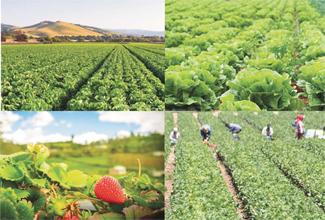Welcome to Blue Book!
Are you ready to join the thousands of companies who rely on Blue Book to drive smarter decisions? View our plans and get started today!
Still have questions? We’d love to show you what Blue Book can do for you. Drop us a line– we’ve been waiting for you.

“We have no plans to decrease the number of acres we’ll farm moving forward,” says Caitlin Antle Wilson, sales and marketing director at the company. “We don’t anticipate many issues regarding labor because of the various programs we’ve implemented.” Tanimura & Antle also offers its workers a 401K with company matching as well as medical, dental, and vision insurance coverage.
“We also work with community-funded projects to remind our employees how special they are,” Antle Wilson adds. An example is the company’s participation in the “Labor of Love” program spearheaded by the Yuma Fresh Vegetable Association in 2015. An opportunity for produce companies to thank agricultural workers, the program included a number of activities and events such as surprise breakfasts delivered to various farms for workers.
Despite such efforts and the creative solutions of some growers, labor issues remain a potent threat to the livelihood of Salinas and other ag-dominated communities.
ONGOING DROUGHT
In 2015 growers continued to struggle through one of California’s most severe droughts on record. In December 2015, the U.S. Department of Agriculture designated 12 California counties as primary natural disaster areas, tied to damages caused by the four-year drought. Although Monterey County was not included on the list, Salinas farmers qualify for natural disaster assistance because Monterey County adjoins other drought-stricken counties.
The Difference in Monterey County
Surprisingly, many Salinas Valley growers remain optimistic about their water supply. “For decades, the agricultural landowners of Monterey County have been funding and operating water resource projects,” says Assistant Ag Commissioner Bob Roach. Because Monterey County is not connected to any state water projects, he says the county must be self-sufficient.
According to Roach, two reservoirs capture water to recharge the aquifer—the main water supply for all of Monterey County. Municipal wastewater is recycled for agricultural use through the Castroville Seawater Intrusion Project and a rubber dam on the Salinas River also captures water to distribute through that system.
“Growers have also adopted much more efficient irrigation methods and technology over many years, and developed more efficient production practices,” Roach remarks. “Of course, the drought of the past few years is still a major concern, but irrigated agriculture continues.”
“We have not experienced water shortages, but the capacity of some wells has dropped by a small percentage,” concedes Dill. “Being that the current drought scenario is one we haven’t faced in over 50 years, current-day farmers are just guessing as to what is happening.”
Antle Wilson says there is not an immediate danger of a water shortage in the areas where Tanimura & Antle grows crops in Salinas. “We’ve been proactive in conserving water for over 30 years,” she notes.
Anomalies, Other Than Little Rain
While the drought classifies as a catastrophe, other weather patterns were considered pretty unusual for the Golden State, many attributed to El Niño. “The weather was our largest issue last year,” contends McDonald of M&M West Coast Produce.
Travis Lee, in sales and dispatch for Dawn Transportation, Inc., a truck broker in Salinas, echoes the same sentiment, but from a different perspective. “The lack of rain has definitely had a negative effect on the transportation industry in California,” he says. “Our company has transported significantly less refrigerated freight out of California over the past year,” he reports, though he acknowledges it was probably not all due to the drought, since various weather events affected the growing and harvest seasons, impacting the vitality of crops.




